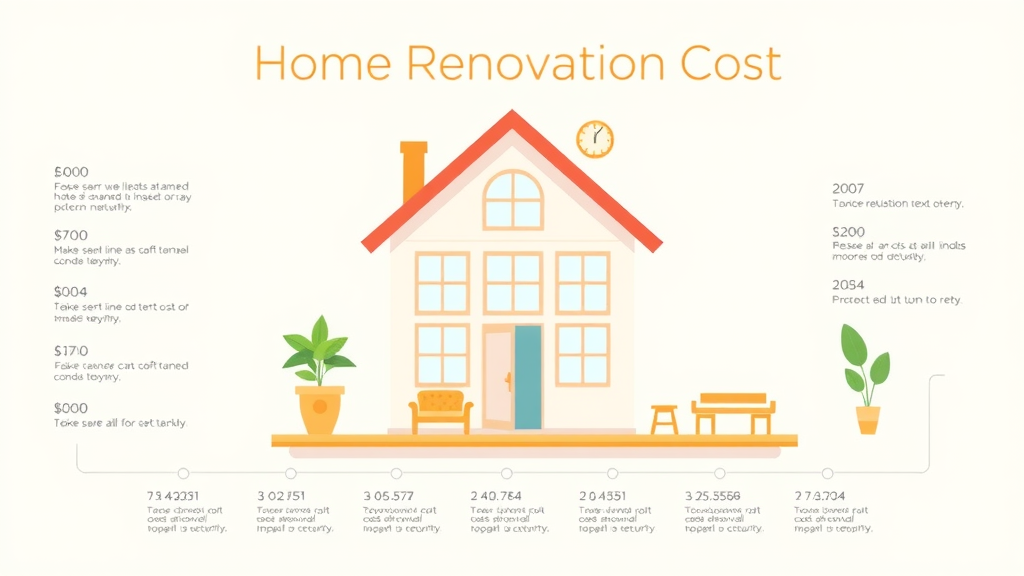Did you know? Over 70% of homeowners exceed their initial renovation budgeting due to hidden costs and unrealistic planning. If you’re tired of cost overruns, sticker shock, and projects spiraling beyond your remodeling budget, you're in the right place. This guide reveals every crucial tip for renovation budgeting so you finally create a home you love—without financially overextending yourself. Let’s dive into a smarter, more sustainable approach to home reno success.

Opening Insights: The True Cost of Renovation Budgeting
Over 70% of homeowners exceed their initial renovation budgeting due to hidden costs and unrealistic planning.
Renovation budgeting is often underestimated—both in effort and importance. Many homeowners assume a few online quotes and some ballpark figures will suffice for their home reno, only to be blindsided by missed expenses, construction surprises, and shifting prices on materials. Proper renovation budgeting means more than tallying receipts; it’s a comprehensive process that directly determines whether your home improvement project becomes a dream come true—or a costly nightmare.
By understanding the real costs behind a remodeling project and how to prepare for the inevitable unknowns, you take control of your remodeling budget and prevent project creep. Whether you’re considering a bathroom remodel, a kitchen renovation, or an entire home remodel, learning how to budget for renovations will save you money, time, and sanity. This information-packed guide arms you with both the data and the practical know-how to keep your renovation budget on course and your expectations firmly grounded.
What You'll Learn About Renovation Budgeting
The fundamentals of renovation budgeting and how it impacts your home reno projects
Common pitfalls in renovation budget planning and how to avoid them
Strategies to save money throughout your home renovation journey
Step-by-step guidance to calculate a realistic home renovation budget
Expert tips for managing renovation costs and maximizing your investment
Understanding Renovation Budgeting: Why It Matters in Home Improvement
Connecting Home Renovation Goals to Your Renovation Budget
Every good home improvement project starts with a vision—but turning that vision into reality requires a budget that matches your goals. Renovation budgeting is the bridge that connects your “wish list” to what’s achievable for your home reno. Whether your dream is a chef-style kitchen with a spacious kitchen island, a spa-inspired bathroom remodel, or just refinishing your wood floor, establishing cost parameters early means fewer compromises and a more direct route to satisfaction.
Aligning your renovation budget with your desired outcomes allows for strategic planning and prevents disappointment. It’s common to want the highest quality for materials or the latest real estate trends, but being realistic about costs ensures you address “must-haves” first—while leaving room for a few “nice-to-haves” as your home improvement project progresses. Being honest with your renovation budgeting right from the start lays the foundation for a successful home reno and eliminates costly detours later.
The Impact of a Realistic Renovation Budget on Home Improvement Project Outcomes
A realistic budget isn’t a limitation—it’s your roadmap to a successful outcome. Homeowners who embrace renovation budgeting are much more likely to complete projects on time, within scope, and with fewer regrets. In fact, a well-planned remodeling budget gives you negotiating leverage with contractors, prevents overextension on home equity loans, and keeps your remodeling project aligned with both your lifestyle needs and your financial reality.
Budgeting realistically also clarifies which aspects of your home renovation are worth the investment—improvements that increase both your comfort and your property value. This type of forward-thinking planning transforms the budgeting process into an opportunity, not a restriction, and allows you to maximize returns throughout your home renovation journey.

Assessing Your Project: Home Reno Scope & Renovation Cost Calculations
Defining Your Home Improvement Project Needs
Before you ever call a contractor or order supplies, sit down and define the scope of your home improvement project. Is it a minor kitchen update, a top-to-bottom bathroom remodel, or a major home remodel involving new square footage? List everything you want done, breaking projects into specific tasks and phases. This clarity allows you to map out realistic cost expectations and ensures nothing essential slips through the cracks—especially when planning a renovation budget that can spiral if underestimated.
Pinpoint whether you’re tackling mostly cosmetic upgrades—like new paint, lighting, or fixtures—or structural changes like knocking down walls, replacing HVAC systems, or new wood flooring. Structural changes are more expensive, require permits, and often involve hidden renovation costs that sneak up on even the savviest homeowners. By grounding your project list in detail, you reduce scope creep, minimize budget surprises, and produce a checklist for accurate renovation cost estimation.
Estimating Renovation Costs: Where to Start
After detailing your improvement project needs, collect cost data from multiple trustworthy sources. Research average cost per square foot for your type of renovation, use online calculators, and consult with local contractors. Remember to include both material and labor costs—and don’t forget crucial budget categories such as design fees, permits, and contingency funds for those inevitable “unknowns.” Building a comprehensive list early in your home reno process makes it much easier to stay on track later.
If possible, ask friends or neighbors who've completed similar home renovations for honest feedback on final costs versus initial bids. Their experience can be invaluable for calibrating your remodeling budget and flagging line items often overlooked. A solid cost estimate is the backbone of every effective renovation budgeting process, setting the stage for compare-and-contrast reviews of bids and, ultimately, more confident financial decisions.

Comparing Remodeling Budget Estimates: Bathroom Remodel vs. Kitchen Renovation
Not all home improvement projects carry the same price tag. A bathroom remodel has different material and labor profiles compared to a kitchen renovation—which usually includes high-ticket items like appliances and kitchen islands. Knowing the average cost and budget allocation for each type enables you to prioritize renovations by impact and affordability.
A bathroom remodel may require significant plumbing but can generally be more contained in both scope and timeline. Meanwhile, a kitchen renovation often means temporary loss of function for a critical living space and greater overall expense. Accurate line-item comparisons help you decide whether to tackle both projects at once, stage them for future budget cycles, or focus on the remodel that best fits your current renovation budget.
Average Renovation Cost Breakdown by Room |
||
Room |
Average Cost Range |
Key Cost Drivers |
|---|---|---|
Bathroom |
$10,000 – $25,000 |
Plumbing, tile, fixtures, permits |
Kitchen |
$25,000 – $60,000 |
Cabinets, appliances, countertops, layout changes |
Living Room |
$8,000 – $20,000 |
Flooring, paint, lighting, electrical |
Breakdown of a Renovation Budget: Essential Line Items
Design fees and permits
Material costs versus labor costs
Unforeseen expenses and contingency funds
Financing home improvement projects
A well-structured renovation budget covers more than just the price of cabinets or new wood floors. It includes design and permit fees, ample funds for both materials and labor, and a dedicated contingency—usually 10-20%—for unexpected issues. Not every improvement project will require the same breakdown, but tracking receipts, estimates, and every renovation cost line keeps you in control. Professional project management apps can simplify tracking and documentation for even the most complex home remodel.
Budgeting for your home renovation also means recognizing the difference between “nice-to-haves” and essentials, ensuring you don’t overspend in one area at the cost of critical components elsewhere. For projects requiring financing, factor loan origination fees, interest rates, and possible timeline extensions into your budget calculations. Every detail matters: meticulous budgeting is the surest way to optimize the value and impact of your home improvement goals.

Popular Approaches to Renovation Budgeting
The 30% Rule for Renovations in Renovation Budgeting
One of the most referenced rules in home reno circles is the 30% Rule: Never spend more than 30% of your home’s value on renovations. This guideline is especially helpful for keeping costs proportional to what your local real estate market will support. For instance, if your property is valued at $400,000, the recommended cap for your home renovation budget is $120,000. This prevents over-improving relative to your neighborhood, which could yield poor returns should you sell.
While the 30% Rule sets a healthy upper bound, always consider your own goals and financial situation. It’s a great check for scope—but if you only need cosmetic upgrades, staying well below 30% often makes sense. For larger renovation projects, however, this rule prevents financial overcommitment and helps secure lender or home equity approval for your improvement project.
Rule of Thumb Budgeting for Home Improvements
Other popular budgeting strategies involve square foot calculations and “percentage of value” checks. For example, budgeting $100-$200 per square foot is typical for a mid-range kitchen remodel or full home renovations, while luxury projects may run even higher. These figures provide a working estimate for early planning and quick benchmarks when evaluating contractor bids or DIY renovation costs.
Adapting these general rules to your specific home improvement project ensures that expectations stay realistic. Use them as baselines, not absolutes—personalize your budget for your home reno, quality standards, and market conditions so you never risk being underprepared.
What is the 30% Rule for Renovations?
Definition and Explanation of the 30% Rule
The “30% Rule” for renovation budgeting is a guideline that suggests homeowners should ideally spend no more than 30% of their property’s market value on all home renovations combined. This approach helps prevent overcapitalization, where expensive updates aren’t matched by increases in home value—a key concern in real estate. The rule acts as a failsafe for significant home remodel or improvement projects, particularly in volatile housing markets.
By maintaining this threshold, you’re more likely to recoup your investment if you sell—aligning your home renovation efforts with both personal satisfaction and smart real estate practices. When total renovation cost starts approaching the 30% mark, scrutinize every new expense and clarify whether it truly supports your improvement goals and local resale potential.
How the 30% Rule Applies in Real Home Reno Scenarios
The real-world application of the 30% rule varies by renovation project. Major overhauls such as a full home remodel or extensive kitchen renovation will push your budget closer to the limit, while targeted upgrades—like a bathroom remodel or new wood flooring—frequently remain well below this threshold. Market conditions, house age, and local real estate trends all play major roles in determining whether to approach or steer clear of the 30% ceiling.
Smart homeowners use the rule as a boundary rather than a mandate. Unexpected renovation costs—whether from structural repairs or code compliance—should always come from a pre-set contingency fund, not from unfettered expansion beyond the 30% line. Keeping a pulse on your local real estate environment and understanding where your home fits is crucial to successful, value-driven renovation budgeting.
Expert View: When to Use or Avoid the 30% Rule in Renovation Budgeting
Industry professionals largely agree the 30% rule is a reliable guideline—but not without exceptions. In lower-value housing areas or markets with rapid appreciation, investing more in high-impact upgrades (like kitchens, bathrooms, or additions) can be justified if you plan to live in the home long-term. However, if you’re renovating primarily to boost resale value within two to five years, strictly adhering to the 30% cap keeps your home reno safely aligned with future marketability.
Ultimately, a flexible approach works best. Always examine your own priorities, risk tolerance, and consult with real estate experts or certified home renovators. Their local expertise provides context that justifies when to follow or deviate from this common renovation budgeting rule.

How Much Should You Budget for Renovations?
Average Renovation Budgets by Project Type
Establishing a budget for renovations starts with an honest assessment of the average cost for each type of project. Nationally, minor cosmetic updates like paint and fixtures may run $2,000 to $5,000 per room, while an average kitchen remodel hovers between $25,000-$60,000. Bathroom remodels typically land in the $10,000-$25,000 range with high-end versions climbing higher. When it comes to a full home remodel, expect to budget anywhere from $100,000 to $250,000 or more depending on square footage and complexity.
Keep in mind, these estimates are ballparks—your local market, the age of your home, and specifics like layout changes or custom features can shift costs significantly. Always get multiple bids and compare with recent home improvement projects in your area for a more tailored renovation budgeting target.
Factors Affecting Your Renovation Budget
Multiple variables impact your renovation budget beyond project type alone. Neighborhood real estate trends may dictate whether to invest in luxury finishes or stick to functional updates. The scope of work and quality of chosen materials can move costs dramatically—a solid wood floor costs more than laminate, and custom cabinetry trumps stock options. Additionally, the difference between cosmetic (paint, hardware) and structural upgrades (foundation, wiring) alters the budget shape significantly.
Hidden costs, like addressing outdated plumbing or electrical issues, can upend even the best-laid renovation budgeting plans. Factor in your improvement project's complexity, required permits, and current labor rates to ensure no surprise breaks your remodeling budget.
Location and local real estate trends
Scope and quality expectations
Type of improvement project (cosmetic vs. structural)
Is $100,000 Enough to Renovate a House?
Assessing a Full Home Remodel on a $100k Renovation Budget
A $100,000 budget can go far—or fall short—depending on the size and condition of your home, regional costs, and project scope. For a modest-sized house, $100k covers most major renovations: a new kitchen, two bathrooms, flooring, and perhaps even cosmetic upgrades to bedrooms and living areas. However, surprises such as structural repairs, foundation issues, or major system overhauls can consume a significant portion of your renovation budget quickly.
To maximize results, allocate funds with precision—focus on high-impact areas like kitchens and bathrooms, and prioritize repairs that assure long-term stability over purely aesthetic upgrades. A $100,000 home remodel is absolutely possible, but requires disciplined planning, value-based choices, and a vigilant eye for hidden renovation costs.
What Can You Realistically Achieve with a $100,000 Renovation Budget?
With proper planning, a $100,000 remodeling budget can cover an array of home improvements. Most homeowners can afford to update the kitchen and at least one bathroom, replace flooring, install new lighting, and refresh paint for a cohesive, modern look. Larger homes may require prioritizing rooms, while smaller homes might allow for a more comprehensive transformation.
The key is to decide early what matters most: Is it function, style, or resale value? Allocate your renovation budget according to those priorities and split funds among projects so each one meets your quality and durability standards—without mid-project cutbacks. A well-balanced approach leads to both increased equity and daily enjoyment.
Cost Savings Strategies for Maximizing Your Remodeling Budget
Efficiency is your best friend when working within a fixed budget like $100,000. Bundle projects to unlock volume discounts, research low-cost material options, and identify tasks you can confidently DIY. Negotiate with contractors and don’t hesitate to adjust project scope if unforeseen discoveries threaten your contingency.
Always keep an eye on expense tracking—knowing where every dollar is spent ensures no funds disappear to waste or ambiguous line items. Home renovation apps, spreadsheets, or even simple checklists can help you monitor spending and ensure your home improvement purchase decisions drive maximum impact across your remodeling project.
Sample $100k Home Renovation Budget Allocation |
||
Renovation Category |
Budget Allocation |
Typical Outlay |
|---|---|---|
Kitchen |
30% |
$30,000 |
Bathrooms |
25% |
$25,000 |
Flooring |
15% |
$15,000 |
Living Area & Bedrooms |
15% |
$15,000 |
Contingency & Permits |
15% |
$15,000 |

How Do I Calculate My Budget for a Home Renovation?
Step-by-Step Renovation Budgeting Process
List desired home improvement projects for renovation
Get multiple estimates for each renovation cost
Set priorities, distinguishing must-haves from nice-to-haves
Include a contingency for unexpected renovation costs (typically 10-20%)
Final review and adjustment for a realistic renovation budget
Begin by itemizing every area you intend to update in your remodeling project. Solicit at least three detailed estimates from local contractors for big-ticket items—like kitchens or bathrooms—and supplement with reputable online data for smaller DIY tasks. Rank each improvement by its necessity and value so you know where it’s OK to scale back. Never skip adding a contingency fund, as unforeseen issues routinely upend the best plans. Regularly review your evolving renovation budget against project progress and continually update to guarantee you never lose control of your financial goals.
Useful Tools and Apps for Home Renovation Budget Planning
Today’s technology makes renovation budgeting easier than ever. Popular apps and digital tools allow homeowners to track expenses, compare bids, and visualize spending trends throughout the improvement project lifecycle. Software like HomeZada, Houzz, or simple spreadsheet templates help keep every detail organized—so you’re alerted the moment receipts push you near your cap.
Some budgeting platforms connect directly to bank accounts or credit cards, automatically categorizing expenses and flagging overages, while others provide real estate market insight or materials cost timelines for smarter future budgeting. Choose a solution that matches your comfort and organizational style, and use it from project initiation through final payment for maximum clarity and control.

Top Tips to Save Money While Renovation Budgeting
Choose cost-effective materials
DIY where possible—know your limits
Bundle projects for volume discounts
Research and negotiate with contractors
Keep track of every renovation expense
"Every dollar you save on supplies is a dollar you invest back into your dream home," says renovation expert Jane Porter.
Financing Renovation Budgeting: Home Equity Loan and Other Options
When to Use a Home Equity Loan for Your Renovation Budget
A home equity loan allows you to borrow against your house’s value to fund large-scale home improvements. It’s ideal if you have significant equity built up, a clear scope, and a plan to pay back the fixed-term loan with interest. Many homeowners use this financing to fund transformative projects—major kitchen renovations, additions, or a full home remodel—where costs extend beyond ready cash reserves. However, borrowing must be anchored in a realistic budget and clear projections for completed value and future resale.
Since your home acts as collateral, default places it at risk—only utilize home equity loans for high-value improvement projects with clear personal or market ROI. Always compare terms, fees, and interest rates to maximize the leverage of your renovation budget.
Comparison: Personal Loan vs. HELOC for Home Improvement Projects
A personal loan requires no collateral but may have higher interest rates and lower borrowing limits than a Home Equity Line of Credit (HELOC). With HELOCs, you utilize only what you need, when you need it—ideal for projects with fluctuating cash-flow requirements or uncertain final costs. Personal loans are best for contained scopes with fixed costs—like a single bathroom remodel—while HELOCs suit multi-stage or unpredictable renovation projects.
Balance the benefits of flexibility, cost, speed, and risk with each option before committing. Consulting both your contractor and a financial advisor ensures the financing model fits your unique home reno and lifestyle needs.
Financing Options for Home Renovations: Pros & Cons |
||
Financing Option |
Pros |
Cons |
|---|---|---|
Home Equity Loan |
Lower rates, large sums available, fixed payments |
Requires substantial equity, risk of foreclosure |
HELOC |
Flexible withdrawal, pay interest only on what’s used |
Variable interest rates, must manage ongoing repayments |
Personal Loan |
No collateral needed, faster approval |
Higher interest, smaller funds, shorter terms |
Cash/ Savings |
No interest, instant access |
Drains liquidity, may restrict project size |

Realistic Budgeting: Avoiding Common Home Reno Pitfalls
Hidden Renovation Costs to Watch For
Nearly every home remodel includes unplanned expenses—such as fixing termite damage, updating to code, or repairing water leaks found behind walls. Always expect 10-20% of your renovation budget to go toward these hidden costs. Obtain thorough inspections up front, and ask your contractor about known risk factors in your area’s real estate (foundation settling, mold, or antiquated electrical).
Listing “what-ifs” and pricing them as part of your contingency protects your budget and timeline from surprises. This is critical for ensuring the final project advances smoothly and your home remains a safe, stable investment.
Managing Renovation Risk and Timeline
Time delays mean higher costs and frustration. To guard your remodeling budget, establish a detailed timeline with milestones and penalties for overruns in your contractor agreement. Monitor progress regularly, documenting scope changes and holding periodic reviews against your budget plan. Proactive management—supported by digital tools—ensures tasks stay on track and all parties are accountable.
Timely delivery protects against both inflated renovation costs and financing expenses such as extended loan interest. A disciplined schedule and open communication with all professionals is gold when tackling complex home improvement projects.
Mistakes in Renovation Budgeting (And How to Prevent Them)
Common mistakes include underestimating total costs, skipping the contingency, prioritizing luxury aesthetics over structural essentials, and failing to fully vet contractors or materials. Prevent them by continuously tracking every cost, scrutinizing estimates, and never launching an improvement project without clear contracts and detailed plans.
Regularly review your renovation budget against actuals and update your scope as necessary to account for emerging needs or setbacks—agility is your best defense.
Expert Quotes: Proven Methods for Renovation Budgeting
"Transparency and preparation are the two pillars of effective renovation budgeting," – Mike Anderson, Certified Home Renovator
Case Studies: Real Home Renovation Budget Success Stories
A Bathroom Remodel That Stayed on Renovation Budget
Lindsay and Carl set a $12,000 cap for their bathroom remodel in a 1960s bungalow. By asking for multiple bids, bundling fixtures with a nearby supply house, and managing demolition as a DIY weekend project, they came in under budget with money left for luxury extras. Their advice: “Track everything. If possible, do some tasks yourself and always negotiate—from permitting fees to cabinet hardware—or you’ll overspend quickly.”
Kitchen Renovation: Saving Money Without Sacrificing Style
Sandy and Arjun faced rising costs in a $40,000 kitchen renovation. When quotes outpaced their renovation budget, they pivoted: choosing stock cabinets over custom, combining labor for flooring and drywall, and finding gently used appliances. Sacrifices in brand names let them stretch their dollars further, ending the project on time and only $500 over their original projection.

Renovation Budgeting FAQs
How much should a renovation budget be as a percentage of home value?
The consensus is never to exceed 30% of your home’s value on combined renovations. For most projects, staying within 10-20% of your property’s current market value provides a safe range, accounting for return on investment and market norms.What are common sources of unexpected renovation costs?
Top sources include hidden damage (like mold or termites), code-required upgrades, permitting fees, price hikes in materials, and scope changes once work begins. Always allocate a contingency fund to offset these surprises.How do I track my renovation budget in real time?
Use digital apps, cloud-based spreadsheets, or dedicated renovation budgeting tools that update expense records automatically. These solutions enable alerts when you approach budget limits, ensuring transparency at all stages of your improvement project.Can you renovate on a tight remodeling budget?
Absolutely. Focus spending on high-impact, must-have updates, be your own project manager, shop for deals or gently used materials, and take on safe DIY tasks to maximize every dollar of your home reno.What is a contingency fund in renovation budgeting?
A contingency fund—typically 10-20% of your budget—is set aside for unplanned costs uncovered during the remodeling project. This protects your overall renovation plan from delays and financial strain.
Key Takeaways: Renovation Budgeting Essentials
Start renovation budgeting early for success
Be realistic with home renovation budget estimates
Always pad your renovation budget with a contingency
Track and document home improvement spending
Leverage professional advice for large home reno projects
Conclusion: Mastering Renovation Budgeting for Every Home Reno Project
Strong renovation budgeting equips you to dream boldly, act strategically, and enjoy your upgraded home—stress free. Start planning, track every dollar, and make your home improvement project a blueprint for success.
When planning a home renovation, it’s essential to establish a realistic budget to avoid unexpected expenses and ensure a successful project. The article “How to Budget for a Home Renovation Project” provides a comprehensive guide on setting a budget, emphasizing the importance of researching average costs, planning for overages, and defining the project scope. (myhomeweekly.com) Additionally, “How to Budget for a Home Renovation and Get the Best ROI” offers insights into prioritizing renovations that yield the highest return on investment, such as kitchen upgrades and outdoor living projects. (axios.com) By consulting these resources, you can develop a well-informed budget that aligns with your renovation goals and financial capacity.
 Add Row
Add Row  Add
Add 



Write A Comment